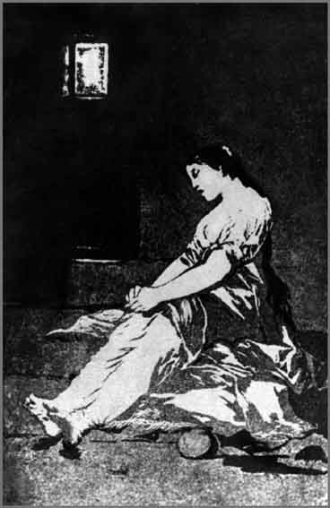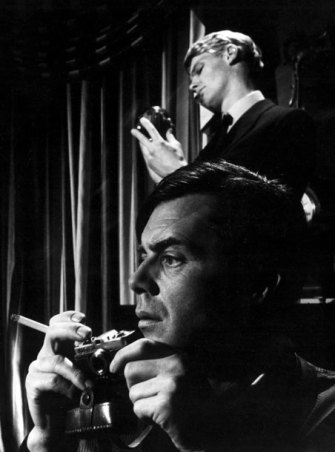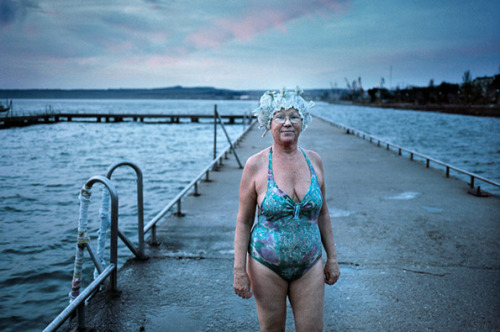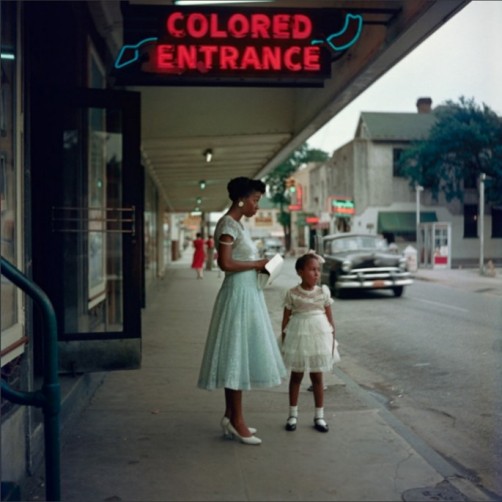
“Gulf Shore Louisiana, 2007” Josef Hoflehner, photography.
“When a couple of local people asked us where we were staying that evening we replied that we would just pull our car next to a park and catch some sleep. Horrified, our new friends told us bluntly that “The Los Angeles Police (LAPD) will pull you out of your car, kick the shit out of you and then arrest you.”
This grim assessment of the LAPD was corroborated in the wake of the 1992 LA riots by a local fifth-grade teacher who told historian Mike Davis that: “In the area where I work, the LAPD is a sadistic occupying army.”
Paul Ortiz,
The Anatomy of a Rebellion (Solidarity)
“…the social contract establishes corporate virtue as an asylum for individual sin, making a moral society out of immoral men; men whose natural inclination, according to Hobbes and Freud, is murder.”
Norman O. Brown
I was thinking about the artists I know personally. In this week of Grand Juries expressly vindicating, almost as a matter of formal announcement, a white supremacist vision for America. The artists I know range from officially non commercially successful, to moderately successful, to famous. I know painters and writers and theatre artists and even a dancer. Somehow, in this week in which black America has begun to find their collective voice and with them the poor in general, and the remaining few sane. But I don’t know if I see enough artists participating, but perhaps its early. Very few white people see this narrative for what it is; a white epic. This is the Epic story of America; slave trader, plantation owner, segregated and hierarchical. Black folk sat over there, white man sat here. There was always racist police in the U.S. In fact, they’re impossible to separate. Police=Racist. There is no police force, as we know it, if there were not clear racial hierarchies to enforce. No police without property, white people property, to protect. No better illustration of this than post Katrina New Orleans. What did the police do? Did they bring water to the dehydrated stuck on rooftops? No, they hurried to secure property from looting. American police have always done the same, and you can look at the LA/Watts riots (uprising or rebellion if you prefer — though I’m happy with the word RIOT…I have no bad associations with that word) of 1965. There was the Fred Hampton murder by Chicago police, and there was those cops beating on Rodney King, or there was Danzinger Bridge, or there were the ‘Rough Riders’ in Oakland in the 90s, and later Oscar Grant. There was Kimani Gray, and Assata Shakur, and there was Hurricane Carter, and going back to 1919, what James Weldon Johnson called *the red summer*, in which twenty cities had “race riots”; culminating in the summer conflict in Chicago. Worth noting that Irish immigrants were later named instigators for a good deal of the violence against blacks, and especially the Hamburg Athletic Club, among whose members was 17 year old future mayor Richard Daley. The narrative though, really, changed very little whether the city was Charleston, or Chicago, Oakland or St. Louis, Tulsa or Knoxville. The cosmetic decorations might change, but the storyline never varies.

Rosewood, Florida 1923, ‘The Rosewood Massacre’
Today the mainstream media manufactures varieties of white supremacist stories to flatter white consumers. It provides ample ideological support for the idea that white’s are not the aggressors in race conflicts, that white’s need to help more, and donate more, and the proof of progress is in the White House, but never do they see that this a story of a lethal white society with it’s boot heal on the black population.
But this is also all rather obvious. And I mean, look, if this ISN’T obvious today, right now, then it is no doubt too late to learn. Eric Garner, a man who was a threat to nobody. On tape. Choked to death. By a white cop. How hard is it to process this storyline? Grand Jury doesn’t indict. So, given the obvious, I want to perhaps look at what I take to be a bit less obvious, and to do so is to delve into the ways in which I believe culture and art matter. Why they are socially radicalizing, potentially.

Fred Wilson. “Cabinetmaking” 1992.
But let me return to the artists I know personally. Those I know who had integrity, and were driven by a seriousness about art, have suffered enormously. Quite literally most are insane. At least they are highly dysfunctional today. And that is because they have not been recognized. The degree to which radical voices are made invisible is extraordinary. Not being seen, literally, makes people crazy. It is an unforgiving culture for those in the arts if they have not gained significant recognition by the age of forty. And to be granted that recognition costs one his or her soul. And this raises questions about how society sees art and those who make art. There has been a tendency that runs alongside the commodification of culture and that is the professionalizing of art, and the less talked about hobby-fication of art. If you don’t make it, in art or anywhere else in this predatory system, and you create things, the psychological safeguard mechanism is to treat it as a hobby. George Bush paints, now. How many actors (movie stars) ended their days as hobby painters? Many many many. But these were celebrities: and they were dabbling, staying *creative*. If you were an auto mechanic and decided at age fifty to paint, you might be seen as troubled and your wife or husband might show real fear. And if you painted weird abstract art or made minimalist sculpture, you would be seen as in need of an intervention.
If you painted fluffy dogs, or landscapes…well, ok, still strange, but not dire. The point is that the second half of the 20th century has turned the very idea of an artist into a cliche.

Theordoros Stamos
The culture of the West, primarily in the U.S. and western Europe, the idea of a commitment to art, irrespective of financial success, is as obsolete as making buggy whips. Or learning to repair typewriters. Today you develop a brand. But this is obvious in a sense, and what is far less obvious is what has replaced the hole in society where artists used to be? The question is not where art used to be, for we still have art. But I am less sure we still have artists. Marx said there is a progressive and regressive side to everything. The regressive aspect to artists resides in the cult of genius, the petulance and primma dona like narcissism. This rise in the idea of a single creative genius is a large topic, but more or less it coincided with the development of the bourgeois burgher, the great businessman, who could buy a portrait, and in this was born today’s idea of individuality. The tortured genius, alone, driven in a search for revelation was the cultural myth applied to the arts. The erosion of this was only in the sense that revelation was abandoned and replaced with brand. What was lost was the sense of radicalism itself, and of conscience. For artists at their best entail a sense, or carry a sense of conscience along with them. Beethoven, Goya, Melville, Tolstoy, or Paul Celan, or even Shakespeare. The work then is unable to separate itself from the material world around it. The culture was defined by this expression, an expression that was oppositional. Even within the status quo, a certain understanding existed, often betrayed, but still, an understanding that the artist was apt to bite the hand that fed it. Material reality was confronted by the historical weight of the artist, and artwork. As Adorno said, “Their enchantment is disenchantment”.The artwork entailed a double character.
“It was plausible that socially progressive critics should have accused the program of *l’art pour l;art*, which has often been in league with political reaction, of promoting a fetish with the concept of a pure, exclusively self-sufficient artwork.”
Adorno

Jean Antoine Watteau, “The Blunder”, 1716.
Artworks, Adorno goes on, posit something spiritual as being independent of the material conditions of production. The artist then, carries with him or herself a sense of guilt and failure, and it is this guilt of being a fetish that is shared by the audience, or viewer, for it is shared by everyone in a society of untruth — and this reaches toward the necessity of fetishes. For in this recognition of guilt, of failure, the artwork (and artist) stand in a dynamic tension with exchange value. Marx noted the fact that Milton’s poems made him little or no money, and to this could be added Moby Dick, a book so vilified by critics and readers that Melville considered never writing again. These works had no market value. No socially useful labor. Art was the hedge against utility, and rationalization.
This is one of the densest sections of Adorno’s Aesthetic Theory. And there is a crucial sentence here that I want to quote:
“Artworks that want to divest themselves of fetishism by real and extremely dubious political commitment regularly enmesh themselves in false consciousness as the result of inevitable and vainly praised simplification. In the shortsighted praxis to which they blindly subscribe, their own blindness is prolonged.”

Sons of Anarchy (2008-2014), FX. Kurt Sutter creator.
This relates to, as Adorno says, the division of labor. The false perception that fetishism is only objectivation. In other words, the societal reception to the artwork is secondary to production of the artwork — interpretation or decipherment of the artwork is firstly an understanding of production, not the hierarchical assessment of its effects, message, or socially agreed upon meaning or appearance. Art is always mediated. If this is looked at in flash forward sixty years (since Adorno wrote) the mediation is complete now, and on a socially total scale. Adorno said that ‘every authentic artwork’ was revolutionary, at least internally. It is a schematic for internal change. Today, the tendency toward integration, by means of this absolute mediation, results in the erosion of what is radical in the artwork. Popularity can kill even the greatest work, and trivialize the artist.
“In the administered world neutralization is universal.”
Adorno

Laurenz Berges, photography.
Neutralization emphasizes again the double character of art. The fact that abstract art is hung in the lobbies of multinational oil company headquarters suggests that what is being tacitly praised by Exxon or Mobil is the titillation of oppositional work which provides the owner with a certain access to that unconscious danger they so steadfastly repress. This is the conflicted area of art’s social role, again. Art is always going to be bad art if it’s intention is to form opinion (per Adorno). The society of domination loves nothing better than to bestow qualities of beauty and nobility upon the very people they terrorize and oppress.
“Real denunciation is probably only a capacity of form, which is overlooked by a social aesthetic that believes in themes.”
Adorno
This truth suggests the pointlessness of agit prop and protest art. It is destined for a bourgeois identification, but this fact is not unique to it, for the false consciousness of all overtly political art is shared by the reception one finds in ironic appreciation of George Bush’s fluffy dogs. There is today, it seems to me, a de facto partiality to all mimetic process. By which I mean, if we take narrative, in fiction, or in film or T.V., the ascension of genre, its spread to almost all corners of human discourse, has assaulted the previously assumed goal of coherence and completion. This partiality or fragmented expression encloses or contains the primary contradictions of Capital. This is why the critique that dismisses, for example, everything that contains violence as harmful, is itself hewing too closely to Puritanical censorship. This is not to say that the wholesale selling of non-stop violence is not a direct goal of a state bent on normalizing the violence it inflicts on its own population, or what the ruling class sees as a surplus population, but that this sort of complaint is simply far too simplistic, and is in formal agreement with the bourgeois structure of policing ideas.

Francisco de Goya
Take for example the TV series Sons of Anarchy. It is easy to see the profligate excess in depictions of violence and sadism, to see its sexism and florid machismo. All this is true and undeniable. But, this is also perhaps the single show I can think of in which the lumpen class, the lowest rung of the working class in America, is honestly depicted. Is this is an accurate representation of biker gangs? Of course not. But after I believe season two, the addition of Kem Nunn as executive producer, and part time writer, signaled a sea change in the sensibility of the narratives and it did become, partially, an honest representation of minimum wage life. This became a show in which everyone, every single character (save the biker gang) was marked by the work they *have* to do, by the soul deadening monotony of wage slavery. The bikers themselves are the only characters (conspicuously) who flaunt their refusal to take day jobs. That is their perceived heroism in a sense. And they pay the societal price for it. This is a landscape of cheap apartments, cheaper bars, garages, discount furniture stores, and strip malls — all are dismal, suffocating and deteriorating. The racial prejudice is presented as self evident, as it is in society. Everyone is sacrificed because nobody has a choice. A world in which routine custody or prison terms is expected, an incorporated part of the system in which the poor must live. Corruption is systemic, and honor is carved out of the debris that is all that remains for the poor. Truck drivers, waitresses, porn actors and transgender hustlers are allowed moments of actual dignity. Nowhere else is class presented quite so clearly in mainstream product. There is also (and I’m sure this is Nunn’s influence) a tragic resignation to the entire arc of the show. It is surprisingly unsentimental. This is a comic book Sophocles in a sense. Lurid, excessive, and exhibitionistic, yes. But one should not discount the genuine awareness displayed on the subject of working class suffering. Nowhere does anyone *win* anything not utterly transient. I suspect those who grew up in this world, or on the edges of it, anyone who can spent time in prison or jail, will not, at least privately, find something resonant in the stories.

The Servant (1963). Joseph Losey, dr.
The point is that this is not the rabid fascistic political fantasy of Madame Secratary or States of Affair, or Aaron Sorkin’s Newsroom. The content is here encloses a social truth, one in which there is no universalizing totalism, no generic bromides save perhaps the virtue of honor, however disfigured. This culture of scientific classification and ironic regressivness, a strange fragmenting of genre takes place in which the residue of all ‘Everyman Plays’ is being, perhaps even unintentionally, worked out. Trauerspiels on Harleys.
Now, this is a question of mediation. For the processes of neutralization that take place are today nearly total. If I had to select a film in the last three or four years that I think most highly of, it would be, probably, Mister John. And here it is important to discern the register in which the viewer is mimetically engaged with a film such as this, and the way in which one can tweeze apart something rare but diminished in Sons of Anarchy. It is a question of navigating the ineffabile and of stepping back from a bourgeois insistence on coherence on the part of the audience. Adorno, again, says in art ideology and truth cannot be so easily distinguished from each other. Today, even within ideology can be found grains of genuine negation. Mister John is so masterful in form, in execution, that mimesis is foregrounded and Utopian promise, even if necessarily broken eventually, is there as aesthetic awakening. In the FX television series, this is not so. One clings to an appreciation of something amid the larger fraud. It is a memory trace, a recognition of a contour that reminds us of something lost, but it also can only do this by an aesthetic action that negates from within the form. And this is discovered in the lobby of Exxon, and to what degree artworks survive that lobby and the implications of this survival. But this form, a corporate produced mainstream TV show, is now of such monumental hegemonic totalizing power that it remains an open question how diminished might be even these few grains.

Jean Antoine Watteau
Brian O’Connor in his essay on Adorno and epistemology says; “…the criterion can be adjusted if it seems no longer compatabile with the object” Experience contains a moment of nonidentical intimation of the specificity of the object. Or, a non-conceptual moment. This is really the place where one starts to talk about the spiritual in art. But it is always linked to a physical material concrete object. For without that concreteness, there is only new age mush. There is only conceptual games of intellect. And that is always reactionary. And this leads into why artists like David Lynch are so tiresome. The production of effects (the *weird* effect in his case) is regressive if not linked to the material world, and I think, by extension to history. Subjectivity is not a receptacle for data. It also does not just invent the world. The individual is making sense of the world and in that way is shaping some part of this experience of the object. The relevant aspect of this for aesthetics is linked up with ideology, and of course with mediation by a society of domination. The vast never ending 24 hour a day onslaught of image and narrative manufactured by a very few generators of information, has raised questions, as stated above, about how diminished cultural life has become. Society is *in* artworks and as such, today, is part of the apparatus of mystification. The shape of the artwork, internally, is reliant, most of time and maybe all of the time to the society in which it is produced. In other words, everything is dependent to some degree on the system of domination. And there is no escape. Its only which avenue one wants to travel. Or which is imposed at any particular moment. In art, in that which aspires in some fashion to negate the status quo, the forces of production are separated in a fashion from their previous role in domination. This becomes about how to unravel the reified commodity artwork, and to what extend obedience is understood, for everything in the marketplace, even if not intended for it, is in service to those who hold power. If the CIA tried to use Abstract Expressionism, it probably failed, but not entirely. Anti commercial art is often more compromised than that which accepts partial mediation (everything, again, is mediated) because (per Adorno) the antithesis is abstract and facile. In a Lynch, there is only the decorative fatuity of a valentine to social domination. But in the same way, agit prop or overtly radically political art is often betrayed by the philistinism of its form.
The very idea of beauty is now so threadbare and compromised that it exists only as Hallmark Greeting card kitsch. And here enters the comforting notion of irony. That velvet painting of Elvis is ironically amusing, maybe even by some pirouettes of logic subversive, but it’s also still a velvet painting of Elvis.

Rafal Milach, photography. “Black Sea”.
Today, the installation or site specific art project, or conceptual (sic) project is a burlesque of sovereignty — for what it is selling is only a pre-shaped reception, complete with free extra attitude thrown in. The very definition of vulgarity is the artist’s insistence on novelty and originality. It is here, too, that genre has arrived in a transformed role. For genre now includes varieties of shopping experience, of marketing, and of its role in relationship to the hegemonic structures that grant visibility to mass product. The affirming of bad taste by mass product, the creation of permission to luxuriate in bad taste is now a stalwart marketing strategy.
The erasure of distance between high and low art has left genre to fill into void. There is really nothing regressive in seeing Shakespeare as a sit com. Not inherently. Not today. The problem is that this usually entails adapting the presentation of Shakespeare to a tradition of formula kitsch, and thereby validating the oppressive state of the audience. So the question of Sons of Anarchy revolves around whether the honesty found in a depiction of working class poverty and suffering is not simply reinforcing an acceptance of this suffering by layering it over with a mock heroism. I suspect this is certainly the case with any number of recent Hollywood films featuring celebrity movie stars slumming it as lumpen characters in cartoon versions of daily oppression. Where once the clown and servant (Losey’s film version of Pinter’s script for The Servant comes to mind) held a place as figures of liberation, today they are simply clowns and servants (Downton Abby). The sentimentality incrusted on comedic or romantic romps featuring Pygmalion like prostitutes or homeless men is the extreme bad faith of this dynamic. Part of this is the erasing of history in such characters. The centuries of sevitude and humiliation that is wiped away by the smile of a rich CEO (Prince) who promises a happy ever after future. In Shakespeare the nobility and royality are aware of there complicity, as are the soldiers or sheriffs in Cormac McCarthy, or Faulkner, or in the criminals of so many film noirs from the 40s. Today’s mass audience, predominately white and educated and reactionary, for film and TV and theatre is one in which contradiction is acute. They survey their cultural market shelf in search of the most flattering forms of titillation, or at least the most normalizing narrative reinforcing their privilege. The catastrophe of Capitalism can only be expressed in a form that echos that catastrophe in form, not in a message that says ‘capitalism is catastrophic’ while humming along in seamless ease. The liberal educated audience today is strikingly reactionary in fact.

Gordon Parks, photography. 1956
The left seems more and more intent on self branding Puritanism, solidifying their hold of micro positions of cool. The buzz kill asceticism of many leftists is only thinly veiled authoritarianism. Attacking Russel Brand for who he dates, or for his good looks or something, rather than seriously examining the fact that his radicalism, however mediated (and god knows its mediated in the extreme) has reached tens of thousands more than those tiresome Trotskyists hawking their tiresome newspapers on street corners. Maybe working with a voice that reaches so many is just common sense. Noam Chomsky has a large stock portfolio, and Naomi Klein is reasonably affluent. This is not a race to the bottom.
So, there is then, running alongside this discussion the recent Ferguson protests, and now Eric Garner. And it is here that in the form of a black community pushed to the absolute brink of endurance, that serious voices of change can be found. For the sense of increasing blindness, or impaired vision, in the white society today, is seen reflected back at them by mainstream cultural product. The overwhelming mono-culture represented not just in news, but in entertainments and art (sic) has a mirror expression in the Grand Jury decisions, absolutely foreordained, in the cases of Michael Brown, and perhaps even more in Eric Garner. The absence of a narrative that actually existed on film in the case of Garner is suggestive of the absence of heterogeneity in all mainstream culture. Garner is invisible except as mannequin/plot point in the never ending saga of white surpremacy. The new story is the same story only told in ever flatter language, in a depthless arid prose and performed by ever more wooden voices; the voices of the both the kindergarten teacher and maitre’d. The district attorney speaking to the assumed superiority of the white audience, a gentlemen’s club wink, a self conscious exaggerated performance of patience at having to endure the bad manners of the crowd, voices of white guidance, and example. For even in the snide ironic narcissism of Lena Dunham or Bill Maher is found the barely hidden stern school marm that will punish after class. All entertainment now is white jingoism, but couched in a narrative sculpted from jailers bent on a bed count once curfew is called. This is entertainment 99% of the time today. And this saturation of sameness is akin today to mental illness. It is also self loathing. Perhaps one reason societies of relative sanity value culture is that atrophied imagination defaults to brutality.

Gaki Zoshi, Scroll of The Hungry Ghosts. Late 12th century. (detail) 日本語: 餓鬼草紙 (がきぞうし)
And in a sense this leads me back to my thoughts about the artists I know. But also, two painters I somehow feel worth mentioning here. One was Theodoros Stamos. One of the younger Abstract Expressionists, Stamos had worked odd jobs, florist, hat blocker, and while studying on scholarship at the American Artists School, he visited Steiglitz’ American Place Gallary. This was a seminal moment for Stamos, as was meeting Ashile Gorky when Gorky came into a frame shop at which Stamos was working. Stamos was from a Greek born family, but was himself born in New York. He gravitated to the immigrant painters of the New York School, and his work was keenly influenced by Gorky and Still, as well as by Baziotes. Stamos traveled most of his life. He was a restless inquisitive man, and later became executor for his friend Mark Rothko’s estate. In between travels he taught for a couple years at Black Mountain College. The involvement with the Rothko estate was to doom his career and reputation, rather unfairly in retrospect. The details are well documented (http://www.huffingtonpost.com/daniel-grant/theodoros-stamos_b_1327696.html) and the shadow that hung over Stamos work never allowed him the recognition he no doubt deserved.
Stamos was a minor painter in that movement, but the best of the lesser artists to be sure (only Marca Relli looks as good). Looking at his work now, in comparison to Baziotes or Brooks or Jimmy Ernst, there is a tensile strength lacking in the others, as well as the influences of Asian aesthetics, a connection he cultivated, that provide something enigmatic. Never a great colorist, it was more in the sense of distance he provided the viewer, suggested to the viewer, the idea of something suppressed or restrained, something that eventually had to be relieved, but was out of view. He died dishonored in 1997. The reason to mention Stamos here is that his itinerant sensibility, his carelessness about commercial return, probably gave his late work a sense of fatalism that is very much worth revisiting. It is odd perhaps to link him to Jean Antoine Watteau, but I’ve always sort of loved Watteau, and found in him a similar fatalism. To love Watteau means to indulge in a sort of guilty pleasure. His quick brush strokes, his lack of formal gifts are compensated for by a wanton louche eroticism. It is always late summer in Watteau, at least for me. It is always afternoon, even when it’s not. Watteau died young at age 36. He was always frail and sickly, according to accounts, and maybe that is what gives his paintings such poignance. He is the forerunner for Fragonard, and probably others, at least in his creation of Rococo summer idylls, what has been labeled ‘fête galante’. The son of a roofer in the provinces, he rose to some renown at the Regency of the duc d’Orléans, in Paris society. But he was an outsider there, a thin somewhat timid man who learned to paint by being employed to paint copies of famous works by the likes of Rubens, to be sold to tourists. Watteau’s world is bittersweet and also fatalistic. Those summers are seductive but never seem realized somehow. They elicit regret in the viewer, a kind of melancholic nostalgia. It is in the work of such artists that one hears those usually unheard voices of history. They are hushed, perhaps, but not mute. Like Stamos, there was the promise of much more that was never realized. But to reach the level of promise is no small thing.

Theodoros Stamos
I find with the writers and painters I know, the theatre artists, that it is very hard to see oneself, after a certain age, as an artist. In this society, the parameters for acceptable success are very narrow. One is allowed to be an auto mechanic, one can do that for one’s entire life and be stamped as unimportant, but not deranged or dangerous. In the U.S. there is even a counterfeit kitsch heroism in certain proletarian jobs. Never actual dignity, for mostly the ruling class has a palpable loathing for the poor.
Many artists I know stop their creative work. They stop writing, stop painting, or they do it privately. The situating of an artwork today includes certain presumptions, certain pre-conditions. One is to have official sanction. A gallery or a residency at a theatre, or regular publications. Without that, your work cannot be seen even when it is seen.
Artworks are not the repository of the creator’s feelings or ideas, they are too altered by what Adorno called “the autonomous nexus of the artwork”. The mimetic process is itself creative in a sense, and it is in this meeting place that the viewer or listener or audience is allowed to lose his or her or their identity. Perhaps this is also, partly, what artists do in creating something. That mimetic process is an intrusive moment of objectivity. For this is the world with the screens pulled away, it is something that approaches an instant of non-mediation. One cannot escape, as an artist, the trauma of the social. In a society today, in the U.S. certainly, in which state authority is now wantonly fascistic, and stunningly sadistic, the possibility of *light* entertainment is feeling increasingly depraved. And this moral stain is not easily laundered, and witness the rise in pitch coming from the giant corporate manufacturers of pop culture. It is a kind of shrieking, that is coupled to a form so eroded and emotionally oxidized, that no amount of bought attention or marketing can make it digestible. Only the elite white class, a certain affluent ownership class now even pretends to normalcy. There is an increased awareness, even if the most prostituted of artists or audience that the fictions of the state are unreal. But hence the doubling down on these fictions. In that three a.m. insomniac gaze at the ceiling the voices of unrest are being heard, however. The last words of Eric Garner are heard. I cant breathe.

excellent article–1 of your best
What seperates Russell Brand’s supposed “radicalism” to that of Molly Crabapple? (Other than different bourgeois publishers & PR flacks..)
The difference is in content. Crabapple pretty much supports the idea of Imperialist policing. Id say brand is a much more honest reformer, and generally across the board critical of a society of inequality. It may not be a deep critique, and there are all the things that go with celebrity, but Id say that is hugely different from laurie penny or crabapple. –For they are also considerably more dishonest in their branding. I dont think Brand (sic) is. I dont think he aspires to be a theorist or anything. Ive not found him a say a single thing I object to. Not yet. His personal life is of little concern. I dont want to be punished for my private life either. But Crabapple called Venezuela a regime. For example. I doubt seriously Brand would say that. I could end up being wrong. But if what he is saying has visibility, it seems self defeating to attack him. Until such time as he needs it. Social change is being led in the US anyway by women of color. And second by black and brown men. So one level, I dont think it will matter greatly,honestly. But….I see the attacks on Brand as symptomatic of something distateful in the left. If Laurie Penny and Crabapple attack Brand…….Im inclined to support him. When richard seymour attacks brand….I KNOW im inclined to support him.
To put it differently then, *how* has his supposed radicalism reached “tens of thousands of people”?
I’d say its entirely the result of Branding and PR, not anything to do with mass political appeal. The producer of his YT show is none other than pro-Iraq war serial plagiarist Johann Hari. He promotes bourgeois pacifism while borrowing the image and rhetoric of Che Guevera, and he’s inclined toward David Ike “spirituality” (he talks about God a lot too, and finding his “inner consciousness” ie: he’s a dilettante).
His original “revolutionary” persona was purveyed by the Guardian & the New Statesman: bourgeois institutions. I should be promoting this simply on the basis he “reaches tens of 1000’s”? Surely i should be working against his ideological malformities and crackpot theories. To me he’s a replica of manufactured dissent with added misogyny and “rock star” appeal.
He’s a Geldof with a slightly more expensive haircut.
Brand is a bourgeois media project in vitiating revolutionary thought and Marxist theory – the same vacuous romantic rebellion that Crab & Co. peddle, its just (slightly) less crass. Speaking of Penny, i have no doubt they mix in the same circles.
In my experience British workers are invariably put off by his dandy act & blatant hypocrisy – not inclined to look further into any message he’s conveying. And this is imo entirely his purpose; workers do not relate to him in the slightest, on the other hand many British petty bourgeois liberals do, and for the same reasons they see virtue in ideologues like Crabapple. His book sleeve promotes “revolution” thats “fun”? FUN!! He hangs with Owen Jones at rallies and calls him “the Orwell of our time” – but he means that as a compliment, not as the reality of them both being liberal imperialists.
Seymour (seems to) oppose Zionism, should we support it then on this basis? The fact is Brand is villified in media but he remains there ad nauseum, he isn’t being ostracised, if anything he’s getting just as much attention as when he was an overt misogynist Kate Moss-shagging celebrity crack fiend. All he is doing is furthering the commidification and decontextualisation of political discourse into apolitical celebrity “activism”. He wont say much about Venezuela because he knows nothing about the subject – why should we be promoting such an imbecile when there are far more qualified and dedicated people to speak on such issues? Why shouldn’t we scrutinise and point out just how counterproductive these ideogues really are and what a huge role they play in pacifying workers in the imperial core?
I agree that there is a systemic problem with attacks within the “Left” that you allude to, but isn’t this just a symptom of the massive ideological disparity and increased apolitical perspective of this homogenous thing called “the Left”? How is it ever to unite without any concrete principles? Imo, Celebrities appropriating revolutionary discourse like Brand only serve to excacerbate this crisis of political acuity and actual practical movement building that is an inevitable consequence of big-tent “Leftism”.
The problem becomes one of perception I think. And this is the problem throughout mass cultural communication. All Im saying is that attacks on Brand, the ones Ive seen, are worse than Brand. What does one do with Brand then? I mean Laurie Penny and Lennard and the rest attack him. And they do so as part of a branding war in a sense. I would never suggest Brand as the leader of social change. But he exists. And his funding or producer or whoever is worth pointing out. As it is with Greenwald say, or any of the Guardian commentators. All of that is what is most useful. That discussion should be foregrounded.– And if one were able to have an informed discussion, then I denounce all of this. But it doesnt seem possible to have that discussion on any broad level.—- I have no idea what the british working class responds to or doesnt respond to. I’m not sure one can even speak in those terms any longer. THAT is part of the problem in fact. I said in another context, (not here) that trying to use Brand’s attention seems the best strategy. How one does that is another question. I wish a million people read your blog, or mine, but they dont. But they read The Guardian. They buy Brand’s book. They subscribe to Crapapple twitter feeds. This is an age of celebrity. I only know that the attacks Ive read on Brand are all for the wrong reasons. And all of them line up with really regressive positions on other matters. And when I read, say, a Penny or danny gold, or the other VICE hacks, I feel something really destructive, really reactionary and manipulative and co-opting is going on. And I dont feel that, on the face of it, with Brand. So, Id rather try to defend some of what his appeal is allowing to be discussed rather than find myself positioned alongside Laurie Penny and Crabapple. (I prefer craPapple, but whatever). I think my de facto defense of Brand is only this question of perception again. Of course he doesnt know shit, but he has also said a number of supportable things. Very general and relatively banal, but supportable. Maybe even accidentally.
In the broader picture yes, this is a commodification of political discourse. But that is happening anyway. Id rather defend his banality than align myself with his attackers. Because I feel what crabapple and penny and gold do is far far far more pernicious. And it co-opts the discourse in far worse ways. Should we just denounce all of them? Yeah, perhaps. But….that implies something, too, and Im not sure its good. And….and…..the above mentioned systemic problem with attacks within the left is extraordinarily crucial. The movement in the US, as I said, isnt going to be affected one way or the other by Penny OR Brand or Greenwald or any of the other corporate backed celebrity commentators. So the only people being affected, I suspect, are a certain affluent(ish) mostly white liberal public. But Id rather engage them via Brand than penny et al. Because they arent politically mature, they are willfully ignorant of history and mostly know only what they read in mainstream media, in Hollywood films and news and the rest of pop culture. Im lobbying for a discussion …..with those people…..from the Brand brand (sic) rather than most others….VICE for example., or the NY Times or MTV. Maybe thats defective as a strategy, but my instinct is that the discussions that come out of Brand’s book are viable…..and Im certain that Penny, and even Seymour, who has become a really arrogant and duplicitous hack, are alienating and exclusionary. Maybe thats the issue for me. That sense of policing behavior and thought, which I find to be predicated upon bourgeois identification with authority. Its policing. Its destructive.
Brand may be mostly empty and silly, and I dont argue in any way that he has substance, but he isnt representing this exclusionary sense of puritanism. And that punishing sensibility bothers me a lot.
I agree that principles matter, and in an ideal world I wouldnt even be having this discussion, but given the hegemony of the Spectacle, its very hard to avoid. Of course I would rather millions bought Samir Amin’s new book, but they dont. I think Im just coming down against this mass cultural front that is positioned as attack dogs on Brand. Why are they so savage in their attacks on him? I dont read the same level of vitriol against Penny? Why? its worth noting that penny and lennard and the rest all went to Oxford or some other exclusive school. So there is something lurking within that that has to do with class. Brand is an easy target on the one hand. Kate Moss shagging crack fiend. Right. But that’s too easy I think. And….it feels too close to what Penny writes. Its this latent moralistic inquisition and I find myself wanting to resist that. I dont really want to defend Brand per se, but given the product wars going on I find him easier to deal with than his attackers.
Phil Greaves: “[Russell Brand is] an overt misogynist Kate Moss-shagging celebrity crack fiend.”
Shame on you. Not just for that grotesquely mean-spirited and revealingly resentment-sodden single line, but for your entire post. At the rare points where it manages not to be wholly content-free, it consists entirely of content that is either demonstrably false, wilfully decontextualised or pitiably trivial.
You should apply for a job with the Guardian or Channel 4, or indeed the Daily Mail, where you can enjoy the company of your moral and intellectual peers.
http://www.dailymail.co.uk/news/article-2857221/Millionaire-comic-Russell-Brand-loses-temper-march-Downing-Street-asked-London-home-worth.html
PG: “overt misogynist Kate Moss-shagging”
Sic(k).
http://anarchy.org.au/anarchist-texts/reich-emotional-plague/
@patrick
That Daily Mail piece is exactly what Im referring to. I dont see that launched against almost anyone else. It is worth examining why and how that happens, because i suspect it is at the heart of my defense of Brand.
John: ” It is worth examining why and how that happens”.
Well, as you know, Reich examined the process very closely decades ago, and “emotional plague” is a good a label for it as any. (Or else the term “penis envy” might be revived, détourned and finally given an actual referent).
Mr Greaves forgot to mention Katy Perry, for some reason.
Btw, we first discussed Russell Brand here 13 months ago:
http://john-steppling.com/no-longer-unaware/#comments
No flash in the pan he. More power to him too. I admire his guts, and I find his development over the last year wholly admirable. He’s not going away. And christ knows there are easier ways he could be making a very comfortable living. (QED.)
A propos: this whole tut-tutting “celebrity” crapola is an irrelevance and a thought-stopping distraction. It is itself merely media-prattle, the most dismally conventional antithought. All the word “celebrity” actually denotes here is Brand’s continuing visibility and audibility, which is (apart, of course, from his looks, wit and vitality) precisely what the media creeps (and their supporters) resent and fear and hate about him since he first had the temerity to go off-book. You can test this easily. Would they take RB any more seriously if he were still an obscure, nameless, impoverished, unemployed drug-addict? Like hell they would. Like hell.
Yeah, Ive yet to hear him say anything I object to. I dont think he claims to be a great thinker, but whatever it is (and I have of course mentioned Reich and the emotional plague several times on this blog in some length) he is upsetting people in ways other visible or celebrity commentators are not. And Im perfectly fine with the fact he is anti puritan, in fact Im glad about it. And Im glad he doesnt apologize for having been an addict. That is what is most supportable. Of course there are mediating factors, as I said in this post or the last one, mediation is total now. There is no visibility without mediation. But if someone says what he says, offends people, AND sells tons of books, then great. And if laurie penny and VICE and all these fucking repressive gatekeepers to authenticity hate him, then for just that I am willing to defend him. He’s not claimed to be more than what he is I dont think. A voice against repression and inequality.
It is precisely because Brand doesn’t “know shit” that he has struck an artery. What he possesses, in lieu of “knowledge” is a moral compass that’s bolted to the floorboards. Where most commentators rely on the ideological “better argument” – a strategy now scientifically discredited – Brand instead counters with unshakable plain old human decency.
The media has glommed on because he’s proven surprisingly adept in defending his issues, but their interest is puerile in the end – and now we give you a blonde who can think, or let’s crack this veneer of decency and expose the avaricious, self serving monster inside, the one that mirrors and justifies us.
Of course the attacks must come from the left as well, because he serves as a constant reminder of how far the left has fallen from its own perilous perch of decency. Brand is no politician. He is no leader. But he is a rather brilliant terrorist of the status quo. Underestimate him at your peril.
S.Beckner: “let’s crack this veneer of decency and expose the avaricious, self serving monster inside, the one that mirrors and justifies us.”
Exactly.